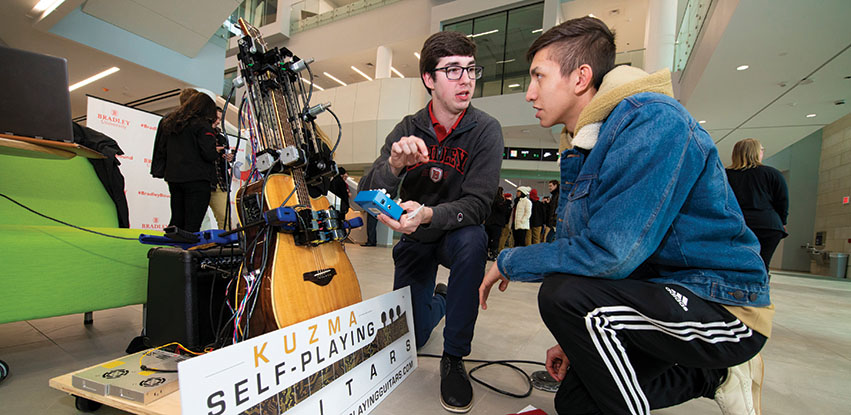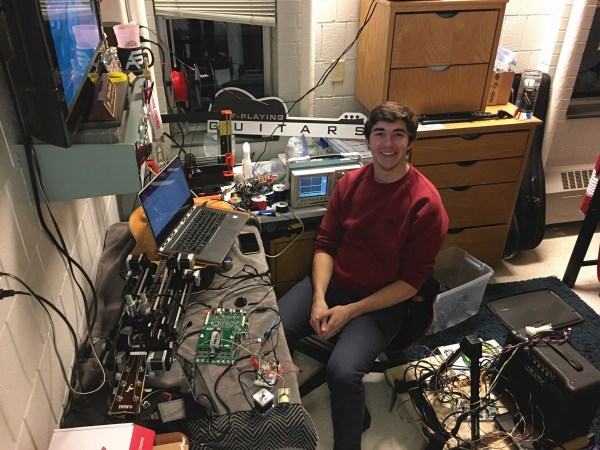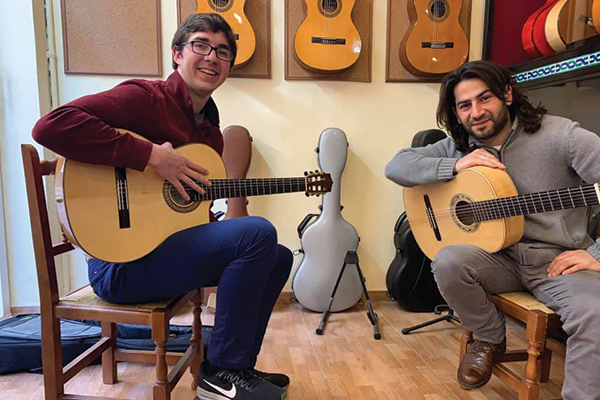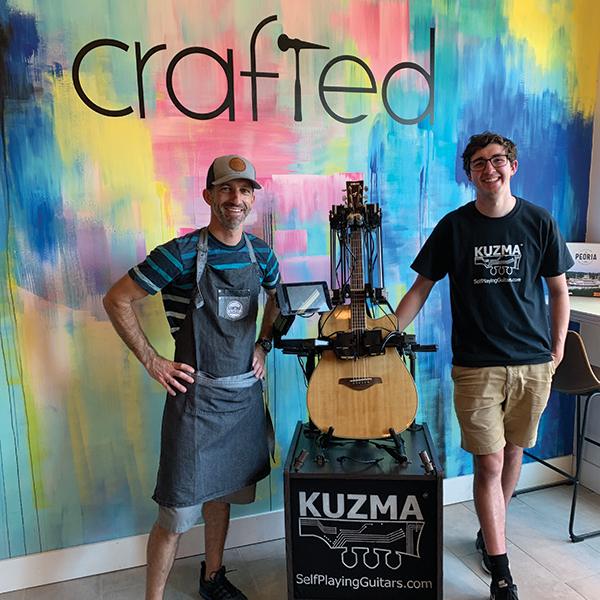
“When people see it live, I get a lot of jaw drops from people looking in disbelief,” he explains. “Then their jaws drop even more when they talk with me and learn more about the process.” The recent Bradley University graduate is discussing his remarkable new invention, the Kuzma Self-Playing Guitar. It’s exactly what it sounds like: a real guitar, connected to a custom circuit board and computer, able to play any song, anywhere, without a human guitarist.
“It’s more mobile and less expensive than a self-playing piano, more available than a live musician, and more dynamic and interesting than a radio,” Michael Kuzma declares. “It’s a new form of musical experience.”
A native of Indiana, Kuzma fell in love with the guitar at age eight, watching intently as his cousin played Green Day songs. He took lessons to learn the basics, advanced to playing school functions and family gatherings, and continued to hone his skills throughout high school. The idea of creating a self-playing guitar came to him during the second semester of his freshman year at Bradley in 2017.
At a mixer for Peoria’s startup community, the electrical engineering major spoke with a tech entrepreneur who challenged him to think of a project where he could apply his lifelong passion for music to his area of study. Later that night, Kuzma got out of bed and wrote out his thoughts at length. “I couldn’t sleep after thinking about the idea of a self-playing guitar,” he recalls. Little did he know, he was sketching out his immediate future… and who knows what else to come.
Solving for Automation
Concepts for automatic musical devices have been around for millennia, dating back to the invention of the pipe organ in ancient Greece. Various accounts from the Middle Ages describe organs that played automatically, while the earliest musical boxes were invented in Switzerland in the late 1700s, building on that country’s renowned watchmaking tradition. The player piano developed and evolved throughout the 19th century—right around the time the first modern guitars were being designed. The complexities of that instrument, however, did not lend themselves so easily to automation.
Three main variables must be controlled in order to automate the guitar, Kuzma says: “picking, fretting and selecting a fret.” This requires an assembly of electromechanical parts mounted to the body and neck, along with sophisticated computer hardware and software to direct their actions. There appeared to be no major technological barriers that could not be overcome; he just needed to put the right pieces together.
Amid extensive research, Kuzma encountered numerous designs for self-playing guitars, including multiple school projects and a failed Kickstarter campaign. But none of them accomplished exactly what he had in mind. “None of these devices were made by guitar players, or their designs essentially made a new instrument in the process,” he explains. “I wanted to preserve the dynamic intricacies… and not manipulate the instrument at all. Many of the other designs weren’t able to play many techniques a guitar player could play, or had immense mechanical noise.”
As he worked out the best combination of parts and processes needed to bring his vision to life, Kuzma found most of his answers simply by asking the right people. One day he cornered a couple of Caterpillar engineers and had them troubleshoot ideas with him. Another time he invited himself over to a friend’s house, knowing his friend’s uncle owned a company that manufactured components he thought might fit the project. He also joined River City Labs, the Peoria-based makerspace, whose members are well-versed in problem solving. “I would go there every week and ask targeted questions,” he recalls. “I received lots of ideas and would try some of them—and one would eventually work.”
Kuzma explains that building incrementally on minor improvements, focusing on one obstacle at a time, and learning from failure are key to the iterative process. “There were millions of different directions I could take… so trying to make the best design decisions is next to impossible until you fail a lot.” He learned 3D printing at River City Labs, a critical step which allowed him to fail cheaply. “I have a large bin full of every single failed 3D print of how to not make a self-playing guitar,” he admits.


From Idea to Entrepreneur
As Kuzma worked through a lengthy series of engineering problems, his initial goal was to create a one-string prototype, after which the system could be replicated across multiple strings. He selected Deep Purple’s hard rock classic “Smoke on the Water” to start with—it was the simplest song he knew that was broadly recognizable and could be played on a single string. He designed a custom circuit board to handle picking and fretting, created a data transcriber to convert sheet music into information the circuitry could understand, and within a year and a half he had a working prototype.
That’s what Kuzma took to Bradley’s 2018 Big Idea Competition, a university-led initiative intended to turn students’ entrepreneurial ideas into real-world business ventures. His team took first place in the contest, which both validated his hard work and came with an $8,000 grand prize. “That provided some seed funding to pull the trigger on possible solutions that I wouldn’t have otherwise,” he explains. Soon he had a three-string prototype that included Ozzy Osbourne’s “Crazy Train” among its five playable songs.
Ready for outside feedback, Kuzma took the device to a retirement community for its first customer trial. In spite of “a few parts flying off” and a “strange thumping sound,” the residents found the music pleasant and therapeutic, though not everyone recognized Ozzy’s heavy metal anthem. Their invaluable feedback was a milestone prior to Kuzma’s study abroad program in Granada, Spain, where he spent five months away from the project and pursued his growing interest in flamenco guitar.
Upon his return to the U.S., Kuzma was ready to get back to work and quickly turned the self-playing guitar into his official senior project. By the beginning of his final semester in January 2020, he had a working six-string. He debuted the device in front of more than 800 people at a Bradley University Visit Day, selecting Led Zeppelin’s timeless classic “Stairway to Heaven” for the demonstration. “I had never heard the device amplified in a large room before this event,” he recalls. The notes rang out clear and true, almost as if guitarist Jimmy Page himself was playing. “I was nearly in tears!”
Riding high on his success and approaching graduation, Kuzma landed an internship with AutonomouStuff, the Morton-based company working to enable self-driving cars and other autonomous technologies—a perfect fit for the ambitious senior. “They put me on their embedded engineering team. Essentially, I learn how specific vehicles work electrically, and then take control of all the vehicle systems. I fake the electrical signals or add new systems to control braking, accelerating, steering, and whatever other systems the customer wants.”
Now working full-time at AutonomouStuff, Kuzma is also turning his big idea into a real business, with patents for his self-playing guitar in the works. “My ultimate goal is to be entrepreneurial within a company, or to run a business/startup,” he notes. Having founded a student organization for entrepreneurs during his freshman year at Bradley, he’s quite literally a poster child for the university’s push to integrate the business and engineering disciplines. Whether working on self-playing guitars or self-driving cars, it’s clear his ultimate goal is well within reach.

Beyond Novelty
Today, the Kuzma Self-Playing Guitar can reliably play almost any song under the sun, though its inventor is still working to remove some mechanical noises and refine the system for smaller venues. He plans to incorporate a range of techniques into the device, including “pull-offs, bends, vibrato, harmonics, percussion and volume dynamics,” and he muses of features further down the road—from automatic tuning, to communication between devices for orchestras, to real-time feedback with accompanying musicians. The same design principles could be applied to other stringed instruments, he adds, though Kuzma remains focused on the guitar for now.
Meanwhile, his Peoria-based business recently began offering rental services. “If you want to make your wedding, fundraiser or special event more interesting or more memorable, I am available,” he notes. And word of his ingenuity is spreading quickly. Kuzma has already demonstrated the Self-Playing Guitar at restaurants, weddings and corporate events. He appeared at ArtsPartners’ Ignite Peoria event over the summer, and this fall he helped launch “Guitar: The Instrument That Rocked The World,” a major exhibition at the Peoria Riverfront Museum. All the while he’s been gathering feedback in order to perfect his creation, guided by a vision that far surpasses novelty status.
“Kuzma Self-Playing Guitars will be in hotel lobbies building first impressions,” he suggests. “They will be in hospitals or retirement homes, rolling room to room for patients in isolation, reminding them of music they once loved. They will enable once-great guitarists struggling with arthritis to get as close as they can to playing again. Kuzma Self-Playing Guitars will be playing while the band is on break, for the singer whose accompanist backed out at the last second, or for the piano player who wants to write a composition involving the guitar.”
He appears to have thought through most every possible use case, and the ink is hardly dry on his college degree. No matter how good the device gets, however, Kuzma assures it will never put human guitar players out of business—something he is sensitive to as a guitarist himself. “There are millions of techniques and players who express themselves through their playing differently,” he stresses. “I am just making a player for a guitar that plays the instrument in its own way. Although more dynamic than a radio, it is not as good as a real, experienced guitar player.
“It’s pretty close, though,” he adds. “And it doesn’t get tired or need to eat.” PM
For booking or more information, visit selfplayingguitars.com.
- Log in to post comments

